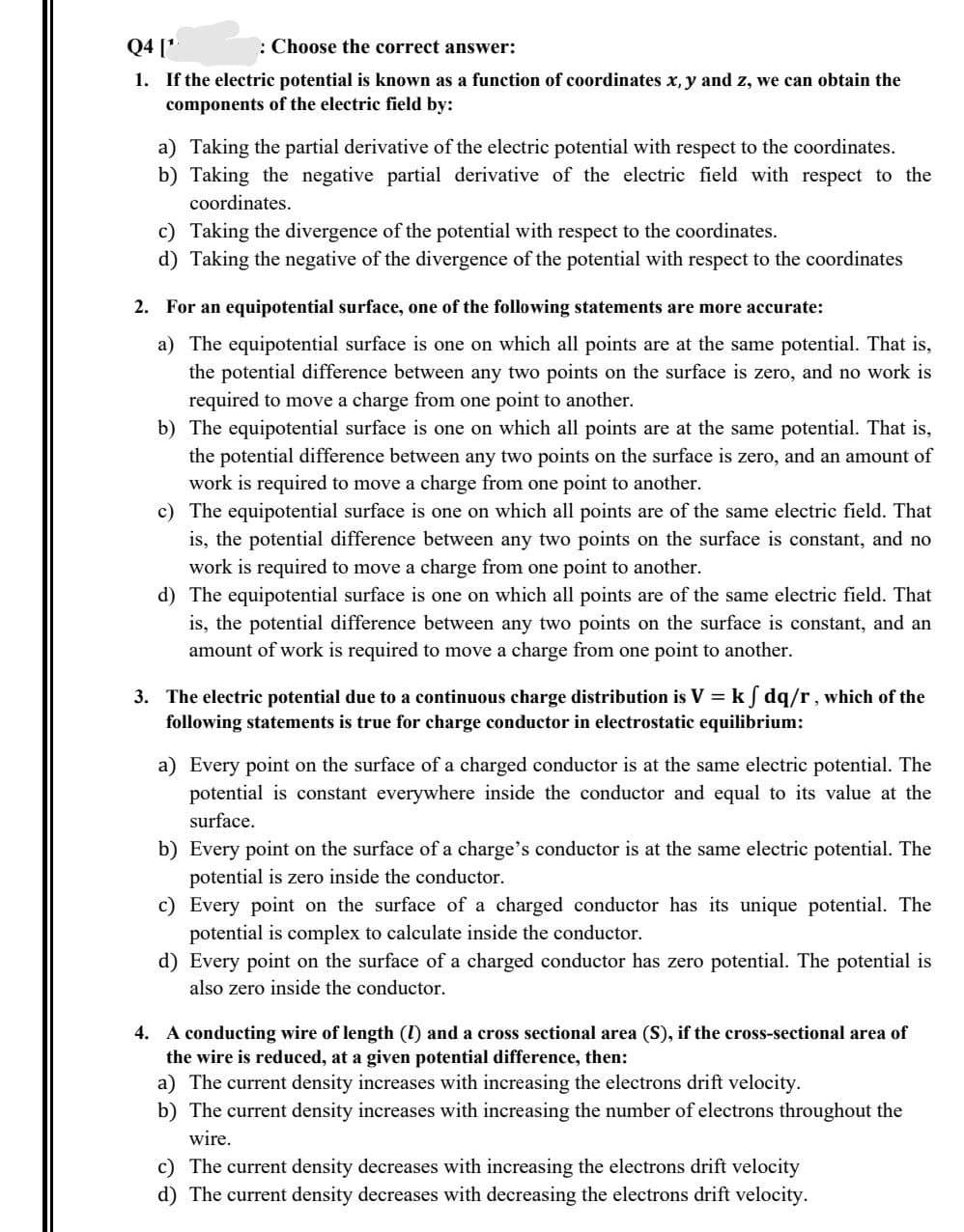1. If the electric potential is known as a function of coordinates x, y and z, we can obtain the components of the electric field by: a) Taking the partial derivative of the electric potential with respect to the coordinates. b) Taking the negative partial derivative of the electric field with respect to the coordinates. c) Taking the divergence of the potential with respect to the coordinates. d) Taking the negative of the divergence of the potential with respect to the coordinates
1. If the electric potential is known as a function of coordinates x, y and z, we can obtain the components of the electric field by: a) Taking the partial derivative of the electric potential with respect to the coordinates. b) Taking the negative partial derivative of the electric field with respect to the coordinates. c) Taking the divergence of the potential with respect to the coordinates. d) Taking the negative of the divergence of the potential with respect to the coordinates
Introductory Circuit Analysis (13th Edition)
13th Edition
ISBN:9780133923605
Author:Robert L. Boylestad
Publisher:Robert L. Boylestad
Chapter1: Introduction
Section: Chapter Questions
Problem 1P: Visit your local library (at school or home) and describe the extent to which it provides literature...
Related questions
Question

Transcribed Image Text:Q4 [¹
: Choose the correct answer:
1.
If the electric potential is known as a function of coordinates x, y and z, we can obtain the
components of the electric field by:
a) Taking the partial derivative of the electric potential with respect to the coordinates.
b) Taking the negative partial derivative of the electric field with respect to the
coordinates.
c)
Taking the divergence of the potential with respect to the coordinates.
d) Taking the negative of the divergence of the potential with respect to the coordinates
2. For an equipotential surface, one of the following statements are more accurate:
a) The equipotential surface is one on which all points are at the same potential. That is,
the potential difference between any two points on the surface is zero, and no work is
required to move a charge from one point to another.
b) The equipotential surface is one on which all points are at the same potential. That is,
the potential difference between any two points on the surface is zero, and an amount of
work is required to move a charge from one point to another.
c) The equipotential surface is one on which all points are of the same electric field. That
is, the potential difference between any two points on the surface is constant, and no
work is required to move a charge from one point to another.
d) The equipotential surface is one on which all points are of the same electric field. That
is, the potential difference between any two points on the surface is constant, and an
amount of work is required to move a charge from one point to another.
3. The electric potential due to a continuous charge distribution is V = k f dq/r, which of the
following statements is true for charge conductor in electrostatic equilibrium:
a) Every point on the surface of a charged conductor is at the same electric potential. The
potential is constant everywhere inside the conductor and equal to its value at the
surface.
b) Every point on the surface of a charge's conductor is at the same electric potential. The
potential is zero inside the conductor.
c) Every point on the surface of a charged conductor has its unique potential. The
potential is complex to calculate inside the conductor.
d) Every point on the surface of a charged conductor has zero potential. The potential is
also zero inside the conductor.
4. A conducting wire of length (1) and a cross sectional area (S), if the cross-sectional area of
the wire is reduced, at a given potential difference, then:
a) The current density increases with increasing the electrons drift velocity.
b) The current density increases with increasing the number of electrons throughout the
wire.
c) The current density decreases with increasing the electrons drift velocity
d) The current density decreases with decreasing the electrons drift velocity.
Expert Solution
This question has been solved!
Explore an expertly crafted, step-by-step solution for a thorough understanding of key concepts.
Step by step
Solved in 3 steps

Knowledge Booster
Learn more about
Need a deep-dive on the concept behind this application? Look no further. Learn more about this topic, electrical-engineering and related others by exploring similar questions and additional content below.Recommended textbooks for you

Introductory Circuit Analysis (13th Edition)
Electrical Engineering
ISBN:
9780133923605
Author:
Robert L. Boylestad
Publisher:
PEARSON

Delmar's Standard Textbook Of Electricity
Electrical Engineering
ISBN:
9781337900348
Author:
Stephen L. Herman
Publisher:
Cengage Learning

Programmable Logic Controllers
Electrical Engineering
ISBN:
9780073373843
Author:
Frank D. Petruzella
Publisher:
McGraw-Hill Education

Introductory Circuit Analysis (13th Edition)
Electrical Engineering
ISBN:
9780133923605
Author:
Robert L. Boylestad
Publisher:
PEARSON

Delmar's Standard Textbook Of Electricity
Electrical Engineering
ISBN:
9781337900348
Author:
Stephen L. Herman
Publisher:
Cengage Learning

Programmable Logic Controllers
Electrical Engineering
ISBN:
9780073373843
Author:
Frank D. Petruzella
Publisher:
McGraw-Hill Education

Fundamentals of Electric Circuits
Electrical Engineering
ISBN:
9780078028229
Author:
Charles K Alexander, Matthew Sadiku
Publisher:
McGraw-Hill Education

Electric Circuits. (11th Edition)
Electrical Engineering
ISBN:
9780134746968
Author:
James W. Nilsson, Susan Riedel
Publisher:
PEARSON

Engineering Electromagnetics
Electrical Engineering
ISBN:
9780078028151
Author:
Hayt, William H. (william Hart), Jr, BUCK, John A.
Publisher:
Mcgraw-hill Education,